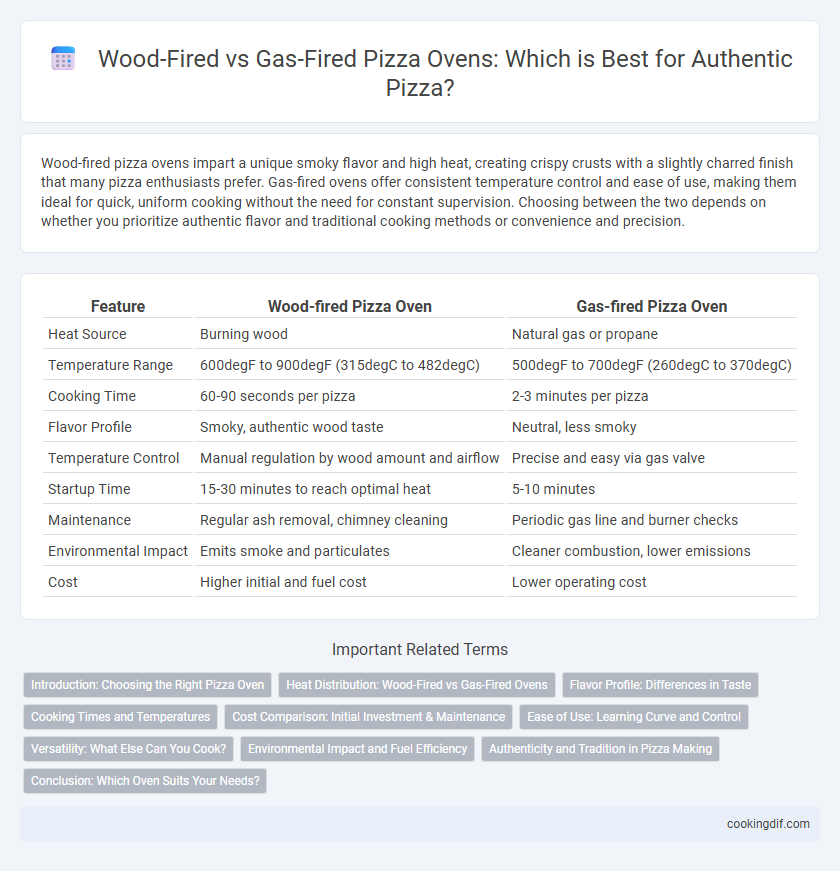Wood-fired pizza ovens impart a unique smoky flavor and high heat, creating crispy crusts with a slightly charred finish that many pizza enthusiasts prefer. Gas-fired ovens offer consistent temperature control and ease of use, making them ideal for quick, uniform cooking without the need for constant supervision. Choosing between the two depends on whether you prioritize authentic flavor and traditional cooking methods or convenience and precision.
Table of Comparison
| Feature | Wood-fired Pizza Oven | Gas-fired Pizza Oven |
|---|---|---|
| Heat Source | Burning wood | Natural gas or propane |
| Temperature Range | 600degF to 900degF (315degC to 482degC) | 500degF to 700degF (260degC to 370degC) |
| Cooking Time | 60-90 seconds per pizza | 2-3 minutes per pizza |
| Flavor Profile | Smoky, authentic wood taste | Neutral, less smoky |
| Temperature Control | Manual regulation by wood amount and airflow | Precise and easy via gas valve |
| Startup Time | 15-30 minutes to reach optimal heat | 5-10 minutes |
| Maintenance | Regular ash removal, chimney cleaning | Periodic gas line and burner checks |
| Environmental Impact | Emits smoke and particulates | Cleaner combustion, lower emissions |
| Cost | Higher initial and fuel cost | Lower operating cost |
Introduction: Choosing the Right Pizza Oven
Wood-fired pizza ovens create intense, radiant heat reaching up to 900degF, producing a crisp crust and smoky flavor prized in Neapolitan-style pizzas. Gas-fired ovens offer consistent temperature control and faster preheating, making them ideal for commercial settings requiring efficiency and uniform cooking. Selecting between wood-fired and gas-fired ovens depends on balancing authentic taste preferences with operational convenience and cooking speed.
Heat Distribution: Wood-Fired vs Gas-Fired Ovens
Wood-fired pizza ovens deliver uneven heat distribution with intense hot spots, creating a characteristic char and smoky flavor favored by artisanal pizza makers. Gas-fired ovens provide consistent, controllable heat with even distribution, allowing precise temperature regulation and uniform cooking results ideal for commercial settings. Heat distribution impacts crust texture and cooking speed, with wood-fired ovens reaching higher maximum temperatures but gas ovens offering steady heat for consistent dough rise and toppings melt.
Flavor Profile: Differences in Taste
Wood-fired pizza ovens create a smoky, charred flavor with subtle hints of natural wood, enhancing the complexity of the crust and toppings. Gas-fired ovens provide a more consistent heat, resulting in a cleaner, less smoky taste that highlights the pure ingredients without additional aromatic notes. The distinct flavor profiles make wood-fired ovens ideal for rustic, artisanal pizzas, while gas-fired ovens suit those preferring a straightforward, traditional pizza flavor.
Cooking Times and Temperatures
Wood-fired pizza ovens typically reach temperatures between 700degF and 900degF, allowing pizzas to cook in as little as 90 seconds, producing a characteristic charred crust and smoky flavor. Gas-fired ovens generally operate at lower temperatures, around 500degF to 700degF, resulting in longer cooking times of 5 to 7 minutes and a more consistent, controllable heat. The higher temperature range of wood-fired ovens accelerates cooking, while gas-fired ovens offer stability and ease of temperature management.
Cost Comparison: Initial Investment & Maintenance
Wood-fired pizza ovens generally require a higher initial investment due to specialized materials like firebrick and chimney systems, whereas gas-fired ovens often have lower upfront costs and easier installation. Maintenance for wood-fired ovens includes regular ash removal and chimney cleaning, which can lead to higher ongoing expenses compared to gas-fired ovens that mainly require periodic gas line inspections and simple cleaning. Overall, gas-fired ovens tend to offer cost savings in both installation and maintenance, making them a more budget-friendly option for commercial and home use.
Ease of Use: Learning Curve and Control
Wood-fired pizza ovens require mastering fire management and temperature control, presenting a steeper learning curve for beginners. Gas-fired pizza ovens offer precise temperature regulation through adjustable knobs, enabling consistent heat and simplified cooking processes. The ease of use in gas-fired ovens makes them ideal for users seeking quick setup and reliable control without extensive training.
Versatility: What Else Can You Cook?
Wood-fired pizza ovens offer versatility by enabling high-temperature cooking that enhances flavor in a variety of dishes such as roasted vegetables, baked breads, and grilled meats. Gas-fired ovens provide consistent and easily adjustable heat, making them suitable for baking, roasting, and even slow-cooking casseroles with precise temperature control. Both types of ovens expand culinary possibilities beyond pizza, but wood-fired ovens excel in imparting a smoky, rich taste to diverse recipes.
Environmental Impact and Fuel Efficiency
Wood-fired pizza ovens emit higher levels of particulate matter and carbon dioxide, contributing to greater environmental pollution compared to gas-fired ovens, which burn cleaner fuels like natural gas or propane. Gas-fired ovens offer superior fuel efficiency, converting energy more effectively and reducing overall fuel consumption during pizza baking. Choosing gas-fired ovens minimizes greenhouse gas emissions and lowers the carbon footprint of pizza preparation.
Authenticity and Tradition in Pizza Making
Wood-fired pizza ovens preserve the authenticity and tradition of pizza making by imparting a unique smoky flavor and achieving the high temperatures essential for Neapolitan-style crusts. This method has been historically favored in Italian pizzerias for its ability to create a perfectly charred, crispy exterior while maintaining a tender interior. Gas-fired ovens offer convenience and consistent heat but lack the distinctive flavor and artisanal heritage that wood-fired ovens provide.
Conclusion: Which Oven Suits Your Needs?
Wood-fired pizza ovens impart a distinctive smoky flavor and intense heat ideal for traditional Neapolitan-style pizzas, while gas-fired ovens offer more precise temperature control and faster preheating for consistent cooking. Choosing between the two depends on your priority for authentic taste and artisanal character versus convenience and efficiency. For pizza enthusiasts seeking rich flavor complexity, wood-fired ovens excel, whereas gas-fired ovens cater better to home cooks or commercial settings requiring speed and uniformity.
Wood-fired vs Gas-fired for pizza oven Infographic

 cookingdif.com
cookingdif.com